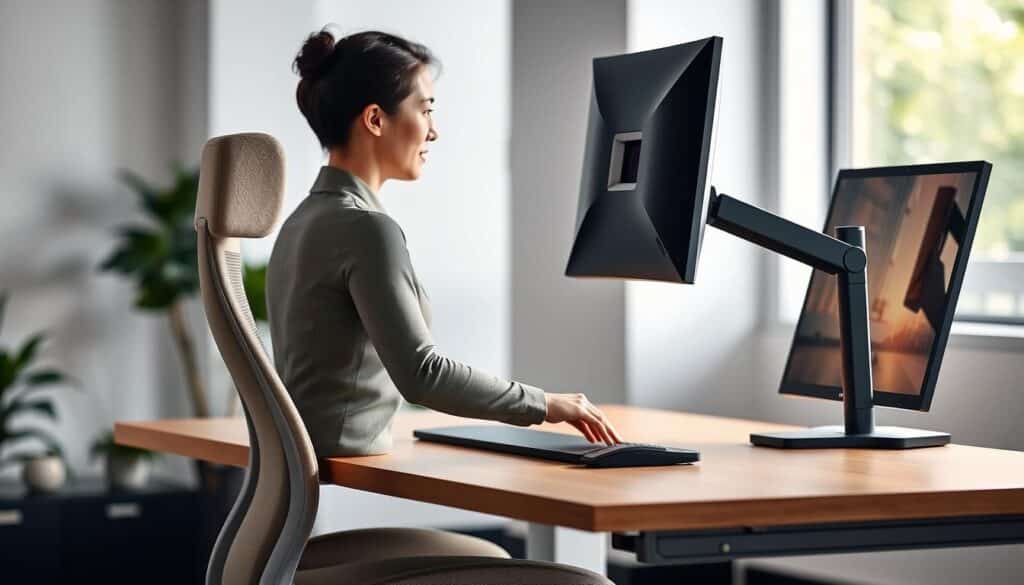Many workers today spend long hours at their desks, often forgetting to look after their health. The dangers of sitting too much are increasing. That’s why it’s key to mix some stretching into your day. This guide will show you hidden office stretching tips. These can make you feel more comfortable and flexible. And you won’t lose focus on your work.
Adding simple stretches to your day can make your office a place of health. You might try a neck roll or stretch your upper body. These actions help ease pain and make you feel good. Keeping active fights the downsides of sitting all day. It also keeps you feeling fresh. Learn how to stay active and sharp with our office stretch tips.
Understanding the Risks of a Sedentary Lifestyle
Living a sedentary lifestyle, especially with desk jobs, is very risky. Most American workers, about 80%, are considered ‘desk potatoes’. This leads to many health problems because of too much sitting. Sitting too long can cause neck and shoulder pain, obesity, and problems with your muscles and bones. It can also make your back hurt and could lead to carpal tunnel syndrome.
Not moving enough increases your chance of getting chronic diseases. People who sit a lot are more likely to get heart disease, Type 2 diabetes, and even some types of cancer, like those of the endometrium and ovary. Sitting too much also means your cholesterol can get worse. This can make your arteries hard and cause other blood vessel problems.
Not being active can also hurt your mental health. Less exercise means less serotonin, which can make you feel anxious, stressed, or depressed. The World Health Organization says not moving enough is a top cause of death. It causes about 70,000 deaths each year in the UK and affects millions in America. Sitting for more than seven hours a day can also increase the chance of dying early by 5%.
Too much sitting can make you less productive and feel lonely, raising the chance of getting sick. Among students, not moving enough can harm how well their lungs work. It can also lower their quality of life. This shows how widespread the effects of sitting too much can be.
The Importance of Regular Movement in the Office
Today’s offices move fast, but many of us are sitting too much. Studies show office workers often sit more than seven hours a day at computers. This can lead to weight gain, diabetes, and even dementia. Especially if you’re sitting for more than ten hours. It’s clear that moving more can break this unhealthy cycle.
A study by Columbia University Medical Center and NPR shows moving regularly can make you feel happier and less tired. Even short stretches or quick walks can sharpen your mind and boost your mood. Setting reminders for movement breaks, or using cues around you, can help keep you active.
People have creative ideas for mixing movement into their day. Sandy Sarber suggests stretching while waiting for the microwave, or carrying groceries in smaller loads. Mireille Mariansky enjoys quick dance breaks to boost energy and make it fun. Jon Hirata likes the idea of team “fit breaks” to add some team spirit to staying active.
Also, think about your office furniture. Standing desks and comfy chairs help ease soreness and improve your posture. Small changes in how your workspace is set up can make it easier to move more. This not only helps you feel better but can also make you more productive.
Secret Office Stretching: Benefits for Desk Job Warriors
Office stretching is very good for people with desk jobs. It helps ease muscle tension and makes you feel more relaxed. Doing stretches during the day can also lower your stress levels. This is because it helps you become more flexible, which is needed when you sit a lot.
Good posture is another big plus from stretching at work. It makes your core muscles stronger. This can lessen back and neck pain from bad sitting habits. Good posture helps you work better and more comfortably.
Stretching is also good for your mind. It helps clear your mind and lowers tiredness. This makes you more focused and productive. Stretching can make you feel more energetic, which is great for staying sharp in the afternoon.
Short stretching breaks at work can also improve your sleep. Many people say they sleep better after stretching daily. So, the benefits of office stretching go beyond just feeling good physically. They also help you stay healthy and mentally sharp.
Simple Desk Stretches to Relieve Discomfort
Adding desk stretches to your day can help ease pain from sitting too long. These easy moves target your upper and lower body. They reduce stress, make you more flexible, and boost your health.
Upper Body Stretches
Stretches for your upper body are key to fixing bad sitting posture. Here’s some that really work:
- Seated Cat/Cow Sequence: Helps with shoulder and neck pain by moving the upper back in a round and arch motion.
- Seated Spinal Twist: Aims at the neck and shoulders, making them more flexible with torso twists.
- Seated Chest Opener: Opens up the chest, shoulders, and upper back by pushing the chest out and arms back.
- Wall Push-Ups: Builds strength in the trunk and arms, lightening the load on the spine while you sit.
- Neck Retractions with Extension: Eases spine stress and stretches the neck, fixing common sitting posture issues.
Lower Body Stretches
Stretches for your lower body tackle tightness in the hips and legs from too much sitting. Try these moves:
- Seated Figure-4 Fold: Works on the hips, glutes, and hamstrings by crossing legs and leaning forward.
- Seated Hip Flexor Stretch: Reduces tension by pulling one knee up to the chest while seated.
- Seated Toe Touch: Reaches the hamstrings, glutes, and lower back with a forward bend over straight legs.
- Standing Quad Stretch: Stretches the quads by bringing one foot up to the glutes while standing.
- Mini Squats: Makes the low back and hip joints more flexible, helping you move from sitting to standing easier.
Incorporating Quick Exercises into Your Work Routine
Quick office workouts boost daily work performance and fight sitting dangers. Stand up briefly every 30 minutes for stretching or marching. Doing calf raises and shoulder rolls for 2-3 minutes refreshes your mind and body.
Use your chair for shoulder presses, torso twists, and leg lifts during breaks. Chair squats are great for staying active without stopping work. Walking meetings are also great for mixing work with exercise, increasing teamwork and health.
Opting for stairs over an elevator easily adds steps to your day. This boosts movement and keeps you active. End your day with stretches for your hamstrings, chest, and hips for a relaxing evening.
Short walks, stretches, squats, or lunges during breaks are key for staying productive. Fitness apps help fit quick exercises into your day. Even simple tasks can become exercise with some creativity, like squats or stretches.
Ergonomics and Your Workspace Setup
A good workspace setup boosts productivity and lessens discomfort. Making your workplace ergonomic impacts your health positively. It creates a comfy setting that helps you work better. Adjusting your chair so your feet are flat on the floor and knees slightly lower than hips is key. This helps prevent lower back strain and improves your sitting posture.
Setting your monitor right is also vital. The screen top should be at or a bit below eye level. This helps keep your neck from hurting and your head position natural. It’s important to place often used items where you can easily get them. This avoids the need to stretch or twist, which can cause discomfort.

Buying ergonomic furniture can make your workspace better. Adjustable desks and chairs offer flexibility. Tools like footrests or lumbar support add comfort. These changes keep your body aligned. They lessen muscle strain and lower injury risk.
Research shows ergonomics can cut down neck and back pain. Taking time to stretch during breaks fights the effects of sitting too long. Using these tips can lead to a healthier, enjoyable work life.
Essential Arm and Wrist Stretches
It’s key to keep your wrists and arms healthy, especially if you’re at a computer a lot. Adding wrist stretches and arm exercises can greatly improve your health at work. Here are some top exercises to make your wrists more flexible and your arms stronger.
Wrist Flexibility Exercises
Making wrist exercises part of your day is crucial to avoid strain. Here are some good stretches:
- High/Low Wrist Stretch: Bend your arms to 90 degrees at your sides with palms down. Bend your wrists down and then up. Hold each position for 5 seconds and repeat 10 times.
- Wrist Flexor Stretch: Sit with your elbows on a table, palms pressed together. Lower your wrists toward the table and hold for 5 seconds. Do two sets of 10 repetitions.
- Wrist Push-Ups: Hold one hand with the other and push up until you feel tension at the wrist. Hold for 5 seconds, release, and repeat 10 times per hand.
- Wrist Turns: With your arms at your sides, bend to 90 degrees and turn your palms up and then down. Do two sets of 10 repetitions.
- Wrist Extensor Stretch: Hold one arm straight out, grasp the back of your hand, and press downward until your fingers point down. Hold for 5 seconds and repeat 10 times per hand.
Arm Strengthening Techniques
Strengthening your arms is also important, along with making them more flexible. Here are easy exercises you can do at your desk:
- Chair Dips: Use your desk’s edge for chair dips to target your triceps. Lower your body and push back up. Do this for 10-15 reps.
- Scorpion Stretch: This helps move your spine and lessen upper body stress. While standing, twist your upper body and extend your arms out.
- Chest Stretch: Stand and put your arms behind you, hands together. Lift your arms a bit to stretch your chest, shoulders, and biceps. This helps fix rounded shoulders.
Exploring Additional Movement Strategies
Integrating effective movement strategies into your daily life boosts your well-being. Adding short walking breaks during the day refreshes you. Walking not only refreshes the mind but also helps you do better at work. Try using stairs instead of elevators to add more activity during your workday. This small change is good for your heart and keeps you energized.
Having standing meetings is another fun way to stay moving at work. These meetings make talking and working together easier, improving work friendships. It’s also good to try new paths to work or change when you arrive and leave. Doing this can make you more creative and focused.
Dynamic stretching makes your body more flexible and lowers the chance of getting hurt. It means moving your joints and muscles to get ready for the day. Doing things like leg swings, walking lunges, and hip circles can make you stronger and better coordinated. These moves also fit well with work activities.
Split your stretching into smaller parts to make exploring these movements easier and improve flexibility. Pay attention to what your body tells you to avoid doing too much and stay safe. Following these tips for being active at work can make your workspace more lively and exciting.
How to Stay Motivated to Move at Work
Moving more during your workday improves health and ups your work game. Simple steps can help you stay active at your desk. Try setting alarms to remind you to stand up or stretch. Walking with your coworkers can make it fun and build teamwork.
Using apps like StretchClock can remind you to move regularly. Creating a healthy vibe at work makes everyone more likely to take part. Sharing your fitness goals can motivate others to get active too.
Incorporate engaging activities during break times, such as:
- Toe Tapping: Quickly tap your toes to music, increasing heart rate and working lower leg muscles.
- Calf Raises: Stand and raise onto your toes, hold, and lower back down while waiting at the printer.
- Seated Leg Raise: While sitting, stretch one or both legs out, hold for five seconds, and lower without touching the floor.
- Shoulder Blade Squeeze: Squeeze shoulder blades together, hold for ten seconds, then release.
- Desk Chair Twist: Sit upright to twist side to side, engaging core muscles.
Try to move every hour to combat the downsides of sitting too much. Desk exercises boost blood flow, reduce pain, and make you feel better. Even quick 5-10 minute activities can fit into a busy schedule. They add up to meet the 150 minutes of exercise we should get weekly. Choosing to move more instead of sitting can motivate you and lead to better health.
Conclusion
It’s clear that secret office stretching is vital for battling a sedentary lifestyle. Adding regular stretches at work improves not just your body, but your mind and mood too. By starting micro-stretching programs, we can work healthier, feel better, and enjoy our jobs more.
Creating stretching plans for different jobs helps make a healthy office setting. This cuts down on work injuries and makes us more productive. Even stretching for five minutes daily reduces muscle pain and boosts our mood. This shows how important it is to keep moving during the day.
In the end, by doing simple stretches at work, employees can make a better work atmosphere. Now is the time to get moving, improve office health, and build a culture that cares about everyone’s wellness. Let’s make our physical and mental well-being a priority every day.



